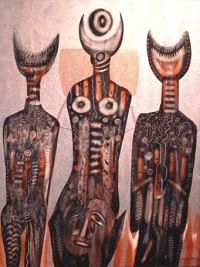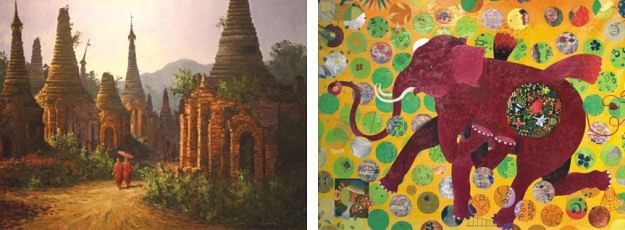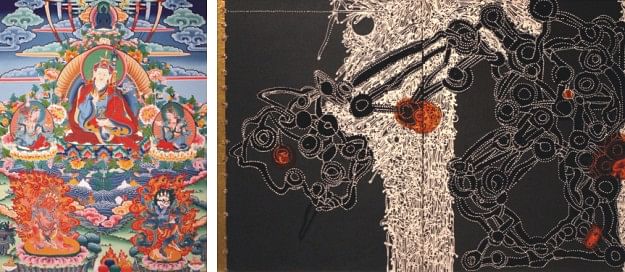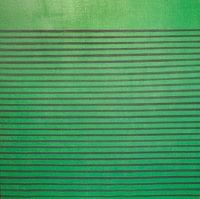Exhibition
Drawing Unity with Colours
“Puducherry Blue”, a South Asian Painting Exhibition gives art lovers of
Dhaka the opportunity to take a tour in the art world of their neighbours.
Tamanna Khan

Amber Hammad, Three things I hate about you.
 |
Birendra Pratap Singh, ECG Puducherry. |
If asked to name any Indian musician, one would not hesitate for even a second to answer. However, naming an Indian artist would prove to be quite difficult for a layperson. Under such a circumstance, it is only natural that one would not have any knowledge about the practise of art in war-ravaged Afghanistan or in undemocratic Myanmar. Fortunately, “Puducherry Blue”, the South Asian Painting Exhibition that is being held at Bengal Gallery, in association with Indira Gandhi Cultural Centre, Dhaka, from January 24 to February 2, 2011 is presenting art works of these countries as well as the other SAARC nations -- Bangladesh, Bhutan, Nepal, Sri Lanka, India, Maldives and Pakistan.
The paintings exhibited at Bengal are from a weeklong art workshop arranged at Pondicherry by Indian Council for Cultural Relations (ICCR) and Sher India in March 2010. Two artists from Afghanistan, Bangladesh, Bhutan, Nepal, Pakistan and Sri Lanka, one from Maldives and Myanmar and 17 artists from the host nation took part in the workshop. Rafiqun Nabi, one of the revered artists representing Bangladesh in the workshop, says, “I have drawn two pictures. In fact, all the participants had to do so. All our paintings will be exhibited in the capitals of the participating nations.”
Out of the two pictures, Rafiqun Nabi's “Seated Women” drawn in a background of different shades of purple, is being displayed at the exhibition. The vibrancy of colours as quintessential of his style is nevertheless presented in the flowers, saree and the rainbow visible through the window. “The other picture is also a work of acrylic. Since Pondicherry is by the sea (Bay of Bengal), the subject has been the beach and the sea,” informs Nabi.
 |
| Kyaw Shein, Shwa in Tein Pagoda. |
Sanjeewa Kumaree, Uncanny Personality. |
“I had taken with me an oil painting on the Panam city. We stayed at the Dune Resort, in Pondicherry, very near to the sea. They had asked me to do a watercolour based on the scenery. But the time was too short,” says Alakesh Gosh whose painting “Nature” is on display. It is a pleasant landscape done in acrylic, depicting the lights and shadows of a quiet Bengali countryside.
 |
Karma Zangmo, Lama Yeedham
Khando Sum (Guru Thangka). |
Amitav Das, Untitled. |
Most of the pieces by the Indian and the Pakistani artists have a post-modern outlook. Ajay Rajgarhia's “Asymmetry” presents an interesting piece created by a pile of folded chairs depicted as a photograph on archival paper. Similarly, Pakistani artist Mahreen's “Remapping Memory 2” adorning the inner wall of the first room, makes the spectators wonder at the dark green parallel lines drawing a pattern on a lighter shade of the same colour. “Three things I hate about you”, a digital picture by Amber Hammad is amusing with its photograph of a woman projecting different roles through her three different headdresses.
Alakesh Ghosh talks about Nepal's senior artist Birendra Pratap Singh and his intricate works depicting the anatomy of the human body with its complex muscles and the arteries. He says that the art camp has given him the opportunity to look at this revered artist's work more closely.
 |
Mahreen Zuberi, Remapping Memory 2. |
Maldives' Mariam Omar's use of the red colour in the presence of delicately drawn dancing limbs, almost gives the impression of blood and is aptly named “Epiphany”. Myanmar's Kyaw Shein painting of pagodas and monks in red cloak brings in serenity and spirituality in the backdrop of a pleasantly drawn landscape. “Song of colour hands,” a handprint on paper by Latifa Meeran from Afghanistan reminds one of the joys of life that survived the decades of war and terrorism.
According to Rafiqun Nabi, there was an ultra modern trend among most of the artists in the workshop. “The Bhutanese artists drew traditional paintings. But the main thing is that we all did our works with fun and all the works were worth mentioning.” He points out the importance of such art camps saying: “Each country has its own trend, and an individual artist follows his/her own style. You can improve your own work and practises by looking at other's works. Such workshops promotes brotherhood and unity among the SAARC nations.”
Copyright
(R) thedailystar.net 2010 |
| |
